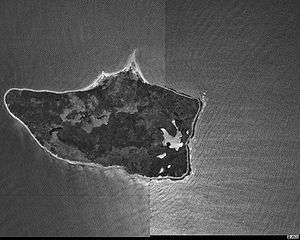Nomans Land (Massachusetts)

Coordinates: 41°15′18.00″N 70°48′54.00″W / 41.2550000°N 70.8150000°W
Nomans Land (also mapped "No Man's Land"[1] or "No Mans Land"[2] or "No Man's island")[3] is an uninhabited island 612 acres (2.477 km²) in size, located in the town of Chilmark, Dukes County, Massachusetts.[4] It is situated about three miles (5 km) off the southwest corner of the island of Martha's Vineyard.
The island was used by the United States Navy as a practice bombing range from 1943-1996. In 1998, the Navy transferred the island to the United States Fish and Wildlife Service for use as an unstaffed wildlife refuge.[3] Due to safety risks from unexploded ordinance and its value as a pristine habitat, the island is closed to all public use.[5]
History

In 1602, from the voyage of the Concord (of Dartmouth) arriving at Cape Cod on May 15, 1602, Captain Bartholomew Gosnold had named the small island "Martha's Vineyard" after his eldest daughter, Martha;[6] however, the name was later transferred to the larger island nearby, northeast of Nomans Land.
The island was probably named "Nomans Land" after a Martha's Vineyard Wampanoag sachem, Tequenoman, who had jurisdiction over the island when the English came in the early 17th century: named from "TequeNoman's Land" (figurative phrase).
An entail of 1695 mentions that William Nicoll of Islip Grange, Long Island, NY owned the Island of Normans Land near "Martins Vineyard" recalling the fact that on December 19, 1685 Gov. Dongan, Lord of the Manor of Martha's Vineyard (including Normans Land) had made Nicoll his Steward there.[7]
An airfield was constructed by the U.S. Navy on the southern edge of the island between November 1942 and May 1944, and the island was used, beginning in World War II, as a practice area for bombers for 53 years, 1943-1996.[3] The airfield was abandoned by the U.S. Navy sometime between 1945 and 1954, though usage as a bombing range continued until 1996.
In 1952 the island was sold by the Crane family to the Navy.[8]
The eastern third of the island has been managed by the Fish and Wildlife Service since 1975. Following an effort to clear the island of ordnance in 1997 and 1998, the rest of the island was transferred to the FWS for use as a wildlife refuge, primarily for migratory birds.[8]
Notes
- ↑ The label "No Man's Land" appeared on Google Maps in November 2006.
- ↑ The label "No Mans Land" appeared on New England-area maps compiled by the National Geographic Society in 1955.
- 1 2 3 "Abandoned & Little-Known Airfields: Southeastern Massachusetts" (airstrip), 2005, Airfields-Freeman.com webpage: Airfields-NoMans.
- ↑ For reasons unknown to history, the town of Chilmark petitioned the Massachusetts General Court to have Nomans Land added to its corporate boundaries in 1716. This petition was granted, although the island had already been included in the original incorporation in 1714. See Annals of Chilmark in the References section below.
- ↑ About Nomans Land Island Refuge
- ↑ "Concord of Dartmouth" (ship arrived at Cape Cod on May 15, 1602), Packrat, 2005, webpage: PackRat-Concord-voyage.
- ↑ Publications of the Order of Colonial Lords of Manors in America - The Nicoll Family and Islip Grange, by Rosalie Fellows Bailey, 1940
- 1 2 MacQuarrie, Brian (July 12, 2010), Officials want it to stay No Man’s Land, Boston, MA: The Boston Globe, p. 1.
References
- Annals of Chilmark, "Nomans Land". From The History of Martha's Vineyard, Volume II by Dr. Charles E. Banks. 1911.
- Blocks 3059 and 3060, Block Group 3, Census Tract 2004, Dukes County United States Census Bureau
External links
- Nomans Land on MapQuest.com - zoom out to see its location with Martha's Vineyard
- Nomans Land Island National Wildlife Refuge at the U.S. Fish & Wildlife Service site
- James W. Mavor Jr.: The Nomans Runestone & Skywatching Shrines NEARA